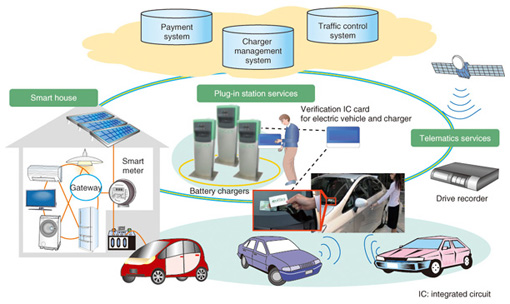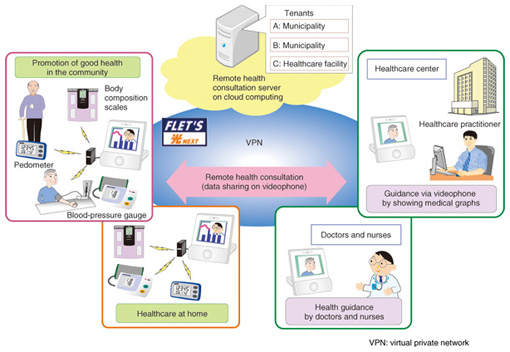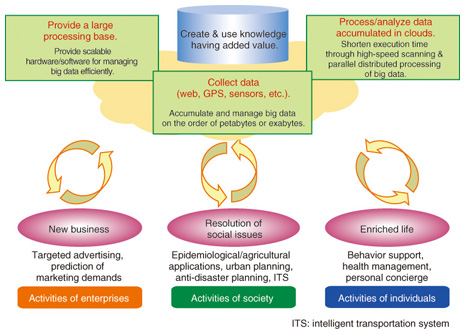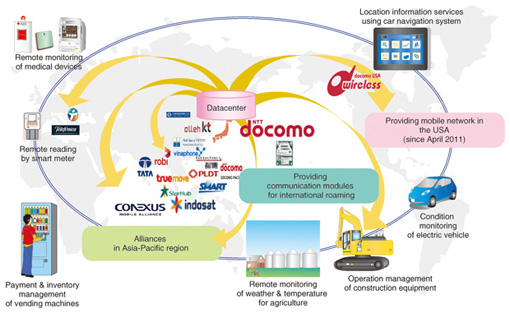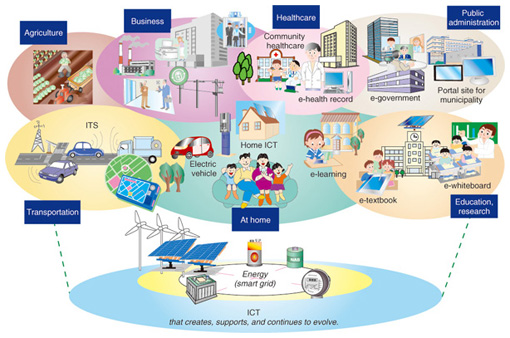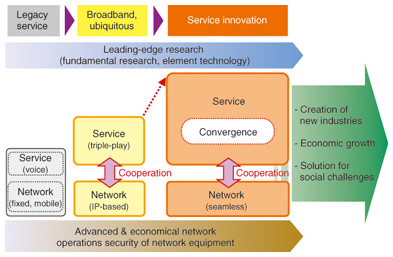 |
|||||||
|
|
|||||||
|
Feature Articles: Keynote Speeches at NTT R&D Forum 2012 Vol. 10, No. 4, pp. 1–9, Apr. 2012. https://doi.org/10.53829/ntr201204fa1  Age of ConvergenceAbstractThis article discusses the progress of convergence between information and communications technology (ICT) and a variety of industries, explains the role of ICT and the importance of innovation in these trends, and presents specific NTT activities. It is based on the keynote speech given by Satoshi Miura, President and Chief Executive Officer of NTT, at NTT R&D Forum 2012, held on February 15–17, 2012. 1. Importance of ICT as revealed by last year’s earthquakeLet us first look back at the Great East Japan Earthquake of March 2011. It was a tremendous disaster. Telecommunications facilities were damaged to a degree that we had never experienced before. In the tsunami-stricken area, cables, telecommunication buildings, and mobile communications base stations were flooded and destroyed, rendering us unable to sustain communication services. In areas not directly hit by the earthquake, traffic rose sharply, making it necessary to restrict communications. People found that they could get better connectivity with packet communications carried over the Internet than with telephone calls. On top of that, we experienced the effects of the nuclear accident and wide-area power outages followed by scheduled rolling power blackouts. This disaster has taught us valuable lessons and reminded us of the vital importance of information communications technology (ICT) and the telecommunications infrastructure. The first thing we did after the earthquake was to install special, free public telephones, satellite mobile phones, and free Internet booths to make a communications environment available as soon as possible (Fig. 1). At the same time, we started work on extending various methods of support: (i) setting up portal sites to provide livelihood-related support information to affected people; (ii) enabling free health consultations via free videophones at evacuation sites in cooperation with relevant not-for-profit organizations to assist in the healthcare of evacuees; and (iii) providing free smartphones, tablets, and electronic textbook and reference-book content to assist in the reopening of school education.
For the future, we are implementing various measures based on the lessons learned from this calamity. (1) Constructing disaster-resistant networks and providing early restoration The most urgent task is to build disaster-resistant networks and put in place means to quickly restore damaged networks. We are taking a multifaceted approach, from providing multiple alternative links in transit networks, to facilitating the use of satellite communications, extending the life of backup batteries, and stockpiling fuel in preparation for prolonged commercial power outages. On the service front, we will introduce a service for sending voice files over a packet network by the end of fiscal 2012. (2) Further promoting the use of ICT in normal times When I visited disaster-stricken sites, I found sheets of paper with safety information written on them posted on the walls of evacuation sites: people had to look at every wall to search for information about their loved ones. And doctors were unable to prescribe the correct medicine for elderly people because their medical records had been washed away. I felt that support at the disaster sites could have been expedited if medical records and residence certificates had been kept in electronic form and stored remotely in the cloud. Such services cannot be launched quickly after an emergency occurs. It is necessary to promote the use of ICT as part of normal life in order to prepare in advance for the next disaster. (3) Utilizing social media Individualized information, such as safety information, that cannot be handled by mass media was collected and posted via social media. In addition, various types of support sites were launched. Social media played a significant role in connecting people. However, they also revealed a downside, such as spreading false or harmful rumors. Although these negative characteristics must be reduced, we have rediscovered the potential of social media. 2. Progress of convergence and the role of ICTWe will now look at the current state of ICT from viewpoints represented by three key phrases and two major trends (Fig. 2).
2.1 Three key phrases(1) Multi-device access (mobile) It has not taken long for smartphones and tablets to grow from their debut to a user base of more than 20 million in Japan, indicating steady progress towards multi-device access. While Japan has led the world in the use of Internet access from mobile terminals, the mobile Internet is now growing on a global scale. This development has given rise to new business models and new types of enterprise. (2) Cloud computing The rise of cloud computing is shifting the business world from owning to using computing resources. Businesses are now using systems in the form of inexpensive, fast services rather than owning their own physical systems. For cloud providers like us, the challenge is not just to provide individual cloud services independently but to make them work together and to automate all processes from the construction to the maintenance of cloud servers in a process that we call orchestration. It is also necessary to meet the needs of customers seamlessly and speedily, and not just domestically but globally. (3) Social networking service It seems clear that the fast and widespread propagation of information through social media assisted the “Arab Spring” revolution. And I already mentioned the significant role played by social media in the aftermath of Japan’s earthquake. Facebook is showing spectacular growth, with its user base now exceeding 800 million. The company applied to go public on February 1, 2012. Its market value is expected to surpass US$ 100 billion. Various types of social networking services, including Twitter, and various types of enterprises have emerged and are increasingly exerting influence on society. Social media are also moving towards socialization by linking with other services. 2.2 Two major trends(1) Globalization Globalization, which started in the manufacturing industry, now encompasses all types of businesses and individuals. As domestic demand levels off and as the enterprises that are our customers increasingly do business globally, it is impossible for us to satisfy their communications needs unless we become more global. The NTT Group has adopted globalization as one of its business pillars in its New Medium-term Management Strategy. In line with this strategy, we have reinforced our service profile so that we can cover all ICT services on every layer and we have expanded our global area coverage, using mergers and acquisitions where appropriate. In the past, it was sufficient to concentrate on Asia, America, and Europe, but today we cannot meet our customers’ needs unless we cover every corner of the world. This is because demand for communications is rising in newly emerging countries, which are now a driving force for global economic growth. Today, the overseas companies affiliated with NTT number 450 (out of the total of 770 affiliated companies) and they employ about 48,000 people (out of the total of 235,000). Since mergers and acquisitions are usually concluded at a premium cost, we believe that their role should not be just addition but multiplication, acquiring technologies, human resources, and time, and generating synergy between affiliated companies. There are still challenges in terms of how to maximize the total power of all the affiliated companies, including how to ensure overall governance. However, we are so far making steady progress, with sales from global business estimated to exceed US$ 10 billion in fiscal 2011. (2) Convergence Convergence, which is one of the main themes of this article, has been evident in many fields (Fig. 3). It has long been actively sought in the technological and academic fields, such as biotechnology and genetic engineering, which arose from the convergence of biology, medicine, and chemistry, and in financial engineering, which combines finance and mathematics. If we look back at history, convergence has clearly been evident in culture and human resources.
Above all, it is in the industrial field that numerous cases of convergence are in progress, such as industry-government-academia collaboration, vertical integration in production, processing and selling of agricultural products, and medical tourism, which combines medical care and tourism and is gaining in popularity in Asia. Moreover, the convergence of ICT and many other industries will be accelerated as many kinds of objects are connected to the network, and various kinds of information are stored in databases. We believe that ICT has two roles to play in advancing these types of convergence. (i) ICT will accelerate the evolution and development of those industries by being incorporated into other industries. (ii) ICT will act as a catalyst for innovation by uniting different industries. In the ICT world, the convergence of fixed-line and mobile communications (fixed-mobile convergence) and the convergence of telecommunication and broadcasting are now taken for granted. For example, a multimedia broadcasting service called NOTTV [1] will be launched on April 1 by mmbi to supplement existing services such as NTT’s HIKARI TV [2] and NTT DOCOMO’s BeeTV [3]. The convergence of ICT and different industries is also giving rise to new markets, new services, and new added value (Fig. 4).
2.3 Convergence of ICT and automobilesThe most typical example of such a convergence is the convergence of ICT and vehicles (Fig. 5). Today, automobiles are effectively moving information terminals. Electric vehicles, which have now begun to take off, can serve as batteries while they are parked at home, and by being combined with smart meters and Home ICT, they can become a key element of a smart home.
Various other activities are also in progress in this field, such as a telematics service, in which moving vehicles exchange information with information systems that make use of the GPS (global positioning system) data of these vehicles, and an intelligent transportation system, which aims to ensure the safety of vehicles by enabling them to communicate with the road and with other vehicles. 2.4 Convergence of ICT and healthcareTo overcome the shortage of medical doctors in aging and underpopulated communities, NTT has been conducting trials of remote medical care in Tono in Iwate prefecture and in Kurihara in Miyagi prefecture. On the basis of this experience, we started a cloud-based remote health consultation service, called Hikari Health Consultation on September 1, 2011 (Fig. 6). Blood pressure data, pedometer readings, etc. of the users are sent automatically from a videophone to the management server. The user can receive health advice and instructions from a remote doctor or nurse while viewing his or her health data displayed in graphical form on the videophone.
We will apply ICT to assist in inter-hospital cooperation. We are also implementing a form of ICT convergence in the Future City Model Project sponsored by Keidanren (Japan Business Federation), which combines healthcare using ICT with an on-demand bus service. 2.5 Machine-to-machine communication and big dataToday, all sorts of information, such as data from sensors, location data, and records of human behavior obtained from mobile phones, can be automatically collected and stored in digital form. After it has been anonymized to prevent personal identities from being revealed, huge amounts of such information (known as big data) can be analyzed to generate outputs useful for marketing, providing personal services, and solving social issues (Fig. 7).
In particular, the global expansion of mobile networks has made it easy to put communication modules into various types of objects, facilitating the collection of information (Fig. 8). For example, Komatsu keeps track of the status of construction vehicles that it has sold around the world and uses the collected information for maintenance and repair purposes. Machine-to-machine (M2M) communication solutions are spreading in many other fields as well, such as inventory management for vending machines.
2.6 Smart communityThe various types of convergence mentioned above will converge into a smart community. There will be convergence of energy and ICT, and then many kinds of objects and services in society, such as electric vehicles and other transport infrastructures, medical care, and city planning (architecture and civil engineering), will be integrated to make them more intelligent than before, and this will make for livable cities (Fig. 9).
3. R&D that drives innovationSome shocking figures were made public this year. One is that, as Japan continues to see its birthrate decline, the country’s population is expected to plunge to below 90 million by 2050. Another is that the country experienced a trade deficit in 2011 for the first time in 31 years. These figures show that Japan has indeed come to a turning point. This is a time when new companies like Facebook are growing dramatically, while Motorola Mobility is bought by Google, and Eastman Kodak goes bankrupt. No enterprise can survive unless it changes. This is a time when Japan must change in order to survive. While some dispute it, others claim that Darwin said, “It is not the strongest of the species that survives, nor the most intelligent, but rather the one most adaptable to change.” Whoever said these words, though, I could not agree more. In the world of ICT, voice-call-centric communication has made way for IP-based communication (IP: Internet protocol), and various types of services have emerged and converged. We have entered the age when services count for more than networks (Fig. 10).
3.1 Importance of continuing to change to seek innovationAgainst the abovementioned background, our research and development (R&D) must also change to achieve innovation. The recent shift in importance to mobility, services, software, and an open source approach reflects the current trend and is gaining momentum. Innovation is to be found not in the extension of current activities but where discontinuity occurs, or where we encounter something different. NTT’s R&D must constantly incorporate new ideas. We are, for example, striving to recruit people from a wide range of fields to expand our diversity. 3.2 Importance of speedIn particular, we must accelerate the speed of R&D of services. R&D must be undertaken in collaboration with operating companies from an early stage. Efforts to achieve this include personnel exchanges between the laboratories and operating companies, such as a program in which newly recruited researchers undergo training in operating companies. NTT’s Research and Development Laboratory Group has also undergone changes. Although this perception may not be right for every research field, we are in a time when we must often undertake R&D with the attitude that an 80% level of product perfection now is better than 90% level two or three years down the road. 3.3 Full-scale globalization of R&DUltimately, R&D itself must go global. NTT has traditionally pursued R&D, developed specifications, and conducted procurement on its own, but this is not the time for such self-dependence. We must aggressively seek information about the latest technologies available in the world and utilize open source software and incorporate them into our home-grown technologies. For this purpose, we reinforced our presence in Silicon Valley in the USA in January this year. We must continue to promote globalization through novel activities. 4. Future activities of the NTT GroupThis article has looked at three key phrases and two major trends surrounding ICT. Among these, it has described service creation through convergence and innovation. Through its R&D, NTT will further invigorate its current activities while striving to create new services by continuing to change as it incorporates new information and technologies from around the world. References
|
|||||||





